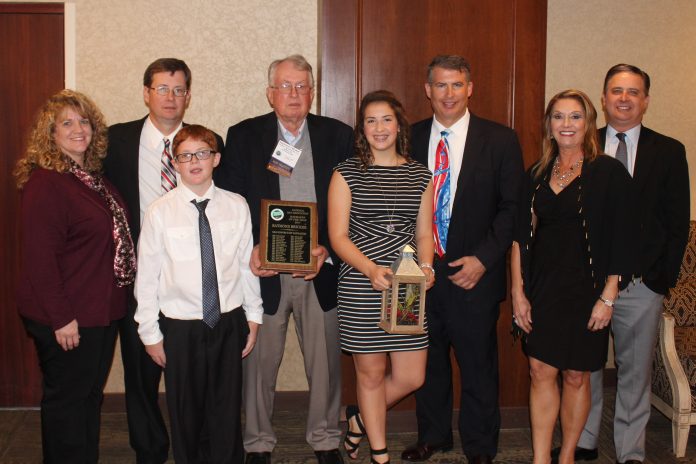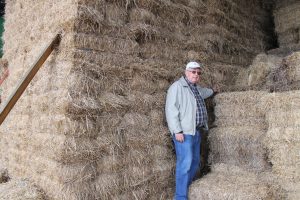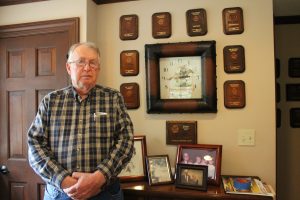
SALEM, Ohio — It used to take six men all day to bale 4,500 bales. Today, Raymond Bricker can do it alone.
His grandfather started baling wire-tied hay in 1923. Bricker, of Salem, Ohio, continued the tradition, growing in acres, bales and keeping up with technology.
Bricker, 76, was named the 2017 Haymaker of the Year by the National Hay Association at its annual convention in Canandaigua, New York, earlier this fall.
Award
“It was an emotional night,” he said. “I had no idea my whole family was there. They announced me as the winner, and then they all walked out, all dressed up — I just couldn’t believe it.”
The association selects people who do a lot of business and do it ethically, he said. Each year since 1985, the association has honored a member deemed outstanding in representing the hay industry.
Bricker, who has been a board member of Agland Heritage Co-op since 1997, farms 1,900 acres, near the Mahoning and Columbiana county border.
This year, he raised 60 acres of hay, 1,300 acres of soybeans, 300 acres of corn, and double-cropped 100 acres of rye. All the land is with n a 10-mile radius of his homestead.
Hay association
Bricker joined the National Hay Association in 1983. He became a director in 1995 and served as president in 2003-04.
He has became good friends with many of the association’s members and continues to do business with them, he said.
“We have shipped hay and straw all over the country,” he said. “We help each other out — when there was a drought out West, we shipped there; when we had a drought in ’88, they shipped here.”
History
In the 1920s, his grandfather, Charles Bricker started selling hay to a slaughter house. Then in the late ’30s, the Brickers hauled straw to large potteries in West Virginia.
“They packed their pottery in our oat straw,” he said.
During WWII, the Brickers hauled straw to paper mills in Dresden and Coshocton, Ohio, where the mills made cardboard out of straw.

(Katy Mumaw photo)
In the early ’60s, they hauled low grade hay and straw to be used as mulch as the government worked on the interstate system, and reclaimed the land around the highways.
They shipped straw and hay to tobacco country, but by the mid-70s, “these markets were only memories,” he said
In 1968, New Holland did their test work at his farm, testing new machinery models on his land and recording their performances.
At one time, he baled 350 acres of hay twice a year, but he believes the days of “big shipping” are over.
“Up to 2004, we baled 70,000 bales a year,” he said “The last I looked, horse numbers in the Carolinas and further south are down 40 percent — it’s just not the business it used to be.”
As the horse market dropped off, Raymond started selling low-grade hay to strip mines, primarily in southeast Ohio. The hay was used by mining companies as mulch for the grass seed they planted to reclaim the stripped land.
For a few summers, he delivered up to five loads a day to the strip mines, all loaded by hand, he said.
Today, he sells straw to gas and oil companies to help them reclaim the land along pipelines.
This past year, Bricker shipped around 25,000 bales. Bricker owns 40 semitrailers, and still has a goal of shipping a load a day.
An early adopter
He has always kept up with technology, buying a pull-type wagon in ’72 and a self-propelled wagon in ’76, one of the first in Ohio, he said.
Before the self-propelled wagon, the hay was stacked on wagons in the field and then hauled to the barn to be stacked. Bricker was glad to have three sons to help with the labor-intensive work.
Now, he uses a 2012 New Holland bale wagon that can move 4,500 bales a day. He has a bale stacker and off-loader, which minimize much of the labor.
“We moved all of this in here without touching a bale,” he said, pointing to the thousands of bales stacked inside one of his barns.
Bricker built each barn and lean-to on his property, including a couple of barns he built out of old bus frames. He took the metal off of buses, welded it together and supported them with steel beams.
“It may not be the prettiest from the inside, but the frames were cheap and still functional,” he said.
Family
Bricker has spent his life in Salem, attending Salem High School and then Ohio State University, earning a degree in agriculture in 1964.
He met Emily Rebecca Walters, who was from Lisbon, in Columbus while he was attending OSU and she was teaching at a local elementary. He returned to Salem and married Walters in 1964.

He helped his dad, Charles Bricker, under the business name Charles F. Bricker & Son, and still operates his business using that name.
In 1970, Raymond and Becky bought the farm he operates today. After 46 years of marriage, Becky died unexpectedly in 2010, and the family has organized a scholarship in her honor, each year giving out two $1,000 scholarships to a West Branch High School graduate who plans to major in education.
The couple has three sons: Tim, a lawyer in Columbus; Ted, a businessman and school board member in Salem; and Rob, a lawyer in Canfield, Ohio; and two grandchildren, Hannah and Samuel.
Still farming
Bricker enjoys spending some of the winter in Florida, but even when he is there, he is often on the phone buying and selling hay and straw. He recently bought the Salem Hills Golf Club, an 18-hole, semi-private club, and spends some time working on the course and helping keep it operational.
His home office is lined with hay judging awards from competitions in which he has participated. When asked how he learned to judge hay, his reply, “If the hay is soft, smells good and is green — it is usually good hay.”









